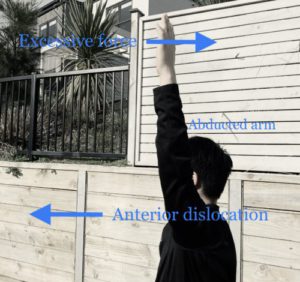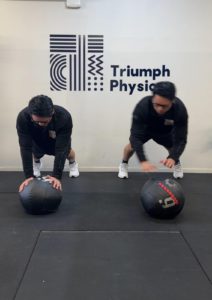-
Overview
The shoulder joint is the most commonly dislocated joint in the human body. More specifically anterior dislocation (where the arm bone dislocates in the front) occurs over 90% of the time. The bony design of our shoulder, a ‘ball and socket joint’, allows for a wide range of movement, and is stabilised by ligaments and muscles. During an anterior dislocation the ball is levered out of the socket often causing injury to the cartilage of the shoulder (Bankart lesion) and then the 2 bones collide together causing an indentation (Hill Sachs lesion).
Risk Factors
- Previous subluxation or dislocations
- Weakened muscles and stretched ligaments around the shoulder
- Involvement in high impact sports or activities
Causes
Anterior dislocations occur mostly when the shoulder is abducted (arm above the head) and an excessive force into external rotation (rotating away from the body) is applied, causing the shoulder joint to dislocate. A common cause of anterior dislocation would be falling or diving on an outstretched arm.

Treatment
- Closed reduction: professionals may try gentle movements to return the shoulder back into position.
- Surgery: If repeated dislocations occur despite going through a strengthening and rehabilitation program patients may be recommended surgery to stabilise the shoulder.
Physiotherapy Treatment
Once the shoulder is back in its proper position rehabilitation is focused on return to normal function and strength.
For rehabilitation, initial exercises often involve gentle range of motion movement to reduce the risk of secondary issues such as muscle wasting or frozen shoulder. Progression is then focused on strengthening and control of the muscle that stabilise the shoulder (primarily the rotator cuffs), and getting proper movement patterns. Sports specific and functional exercises could be incorporated into the later stage of rehabilitation to ensure safe return to normal daily activities.
References
Longo et al. (2014). Management of Primary Acute Anterior Shoulder Dislocation: Systematic Review and Quantitative Synthesis of the Literature.
Cutts et al. (2009). Anterior shoulder dislocation.

Anterior Shoulder Dislocation
- Post author:Triumph Physio
- Post published:05/09/2020
- Post category:Physiotherapy / Shoulder
Tags: anterior shoulder dislocation, physical therapy, physio, Physiotherapy, rehab, rehabilitation, shoulder, shoulder dislocation, Shoulder injury



